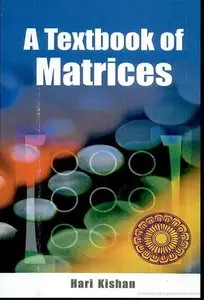A Textbook of Matrices by Hari Kishan
English | 2008 | ISBN: 8126910011 | 467 pages | PDF | 13,6 MB
English | 2008 | ISBN: 8126910011 | 467 pages | PDF | 13,6 MB
A matrix is an ordered set of numbers listed in rectangular form having certain rows and columns. The knowledge of matrices is considered necessary in various areas of Mathematics and a wide variety of other subjects, like Chemistry, Sociology, Genetics and Electrical Engineering. The importance of Matrix Theory has greatly increased with the invention of Electronic Brain—Computer. It has become a powerful tool of modern Mathematics and is now extensively used in the allied fields of Mathematics including Probability, Statistics, Quantum Mechanics, Mechanics, etc. A Textbook of Matrices covers all the important topics on matrices. The subject matter has been divided into nine chapters.
Chapter 1 explains multiplication and addition by scalar, commutative and associative matrices. Special kinds of matrices like Symmetric, Skew-Symmetric, Hermitian, Skew-Hermitian, Involutary, Orthogonal and Unitary have been dealt with in chapter 2. Determinants of matrices have been taken up in chapter 3 which also explains various types of permutations and inversions, Sarrus’s rule, cofactor of an element and properties and working rules of determinants. Chapter 4 takes up adjoint and inverse of a matrix and explains elementary operations and symbols. The rank of a matrix, invariance of rank through elementary transformations and reduction to normal form have been dealt with in chapter 5. Since matrices are widely used to understand different forms and systems of linear equations, chapter 6 has been devoted to the study of linear equations in relation to matrices. Chapter 7 deals with linear independence and dependence of vectors and explains the difference in vectors. Characteristic roots and vectors in Cayley-Hamilton Theorem have been analysed in chapter 8. Since quadratic forms are one of the three most frequently encountered homogeneous forms, chapter 9 explains quadratic form as a matrix product, linear transformations and reduction of quadratic forms into sum of square forms.
The book is an ideal textbook on matrices. The language is simple and approach thoroughly illustrative. Several examples and theorems have been included for complete understanding of various concepts. A number of exercises have been added to provide sufficient practice to the students. It will prove immensely useful to the students and teachers of matrices.
About Author:
Hari Kishan is Senior Reader in Mathematics at Kishori Raman Postgraduate College, Mathura, affiliated to Dr. Bhim Rao Ambedkar University, Agra. He has 36 years of teaching experience of degree classes to his credit. He completed his M.Sc. from B.S.A. College, Mathura in 1971 and obtained a record percentage of marks for which he was awarded Gold Medal by Agra University. He received Ph.D. degree in Mathematics (Fluid Dynamics) in 1981 from the same university. His topic of research was ‘Flow of Homogeneous or Stratified Viscous Fluids.’ He has got published numerous research papers in several mathematical journals of repute. Besides, he is a well-known author of a large number of books on Mathematics, including Trigonometry, Integral Calculus, Coordinate Geometry of Two Dimensions, Coordinate Geometry of Three Dimensions, Matrices, Modern Algebra, Theory of Equations, Dynamics, Statics, Hydro Statics, Real Analysis, Numerical Analysis, Sure Success in Convergence and Differential Calculus.



